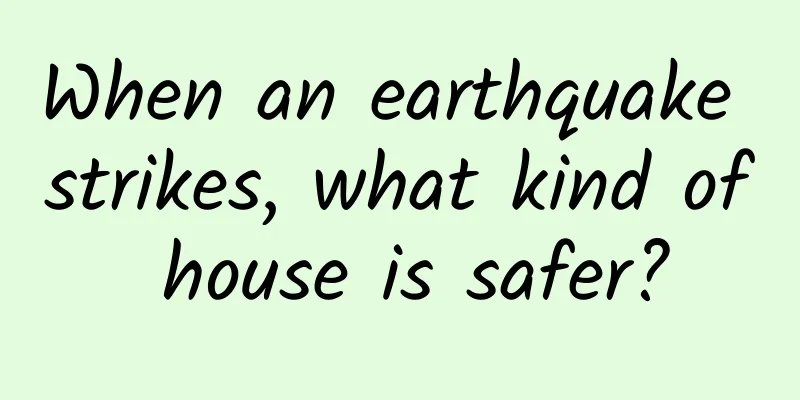When an earthquake strikes, what kind of house is safer?

|
At 23:59 on December 18, a magnitude 6.2 earthquake occurred in Jishishan Baoan, Dongxiang and Salar Autonomous County of Linxia Hui Autonomous Prefecture, Gansu Province, with a focal depth of 10 kilometers. As of 9 a.m. on the 20th, the 6.2-magnitude Jishishan earthquake has caused 113 deaths and 782 injuries in Gansu Province. Figure 1: On December 19, rescue workers carried out rescue work in Dahejia Town, Jishishan County. Photo by Xinhua News Agency reporter Zhang Ling Xu Xiwei, founding president of the National Institute of Natural Disaster Prevention and Control and professor at China University of Geosciences, said the number of casualties in this earthquake was unexpected. A magnitude 6.2 earthquake is a moderate-intensity earthquake, and unlike strong earthquakes such as the Wenchuan earthquake and the Yushu earthquake, such "background" earthquakes have a higher incidence rate. There are many reasons for the large number of casualties in this earthquake. One of the important reasons is that the earthquake resistance of the house is relatively insufficient, and it is easy to collapse or have side walls collapse under vibration damage conditions. So how do earthquakes damage homes? And what kind of homes are safer during an earthquake? Earthquakes are caused by changes in the earth's crust, which generate vibrations. Then, the vibrations are transmitted to surrounding houses in the form of seismic waves, causing damage to houses. The cause of this vibration source may be activities between plates, volcanic eruptions, rock collapse, etc. As shown in Figure 1 below, seismic waves can be divided into three types: longitudinal waves (P waves), transverse waves (S waves) and surface waves (L waves). When the wave source is generated, these three waves will start to run like the three cars in the picture, but their forms and speeds are different when they are running. Figure 2: Illustration of seismic wave propagation The P wave is like the green car in the picture. It vibrates in the same direction as the propagation direction, has the fastest speed, and is the first to reach the ground, causing the ground to vibrate up and down, but it is less destructive. Following closely behind is the S wave represented by the red car. Its vibration direction is perpendicular to the propagation direction, causing the ground to shake left and right and front and back, which is more destructive. Finally, there is the surface wave (L wave) represented by our blue car. It is a new seismic wave generated by the P wave and the S wave on the surface. It can only propagate along the surface of the ground and is the main factor causing severe damage to buildings. Figure 3: Schematic diagram of an earthquake occurring and affecting a house Although earthquakes are terrible, not all earthquakes cause damage. According to relevant statistics, there are an average of about 5 million earthquakes per year in the world, but we can actually feel about 50,000 earthquakes, and about 100 of these earthquakes may cause damage. Next, let's take a look at the impact of the remaining 100 destructive earthquakes on houses. The picture below shows two masonry structures in Beichuan County during the 2008 Wenchuan earthquake. The two buildings were less than 50 meters apart, but the difference in damage was astonishing. Through observation, we can see that the biggest difference between the two is the ring beam-structural column. Figure 4 does not have a ring beam-structural column, and the collapse is serious; while Figure 5 has a ring beam-structural column, only part of the wall has X-shaped cracks, but the main structure is not damaged, and basically no harm will be caused to personnel. Figure 4 Masonry structure of structural columns without ring beams Figure 5 Masonry structure with ring beam and structural column I believe everyone has the experience of packing a package in life. If a package is not wrapped with packing tape around it, it will be very loose. In the same way, the ring beam-structural column acts as a packing tape in masonry buildings, connecting the loose floor slabs and masonry walls into a whole, which improves its earthquake resistance. In addition to the damage to masonry structures, there are also many frame structure damages at earthquake sites. Figures 6 and 7 show frame structure damages at earthquake sites. In Figure 6, the masonry filling wall in the middle of the bottom frame was sheared, forming an X-shaped crack, and in Figure 7, the columns at the corners were damaged. Figure 6 Damage to the masonry infill wall inside the frame structure Figure 7 Damage to the frame columns of the frame structure So why does such damage occur? This is where the word stiffness comes in. Stiffness refers to the ability to resist deformation. The greater the stiffness, the stronger the ability to resist deformation, but it will also bear greater earthquake effects. Whether it is the masonry infill wall in Figure 6 or the column with a half-height window sill in Figure 7, they will cause their own stiffness to increase, resulting in uneven stiffness. In this way, the greater the stiffness of the component, the more serious the damage in the earthquake. This is what people often say, "the more capable you are, the more work you will do." Since you have a high stiffness, you will bear more, but in the end you will also be the one who is most seriously injured. In the 9.5 Luding earthquake, the above-mentioned types of damage also reappeared to a greater or lesser extent. The figure below shows the relevant situation of the damage caused by the Luding earthquake. Figure 8 Shear failure of internal masonry infill wall Figure 9 Damage to the internal decorative layer of the frame structure Figure 10 Filling the X-shaped crack in the wall Figure 11 Overall collapse of the bottom floor of the frame structure We have already seen the specific forms of damage to houses in earthquakes. So, how can we reduce these earthquake damages? The most popular technology now is seismic isolation technology. Today, let us take a brief look at this secret. Seismic isolation technology refers to isolating the building structure from the ground through some seismic isolation devices, absorbing ground vibration through the deformation of the seismic isolation layer, thereby protecting the upper structure from earthquake damage. The figure below is a simple schematic diagram of the seismic isolation principle. Figure 12: Schematic diagram of seismic isolation principle In addition, energy dissipation and shock reduction technology is to set some non-load-bearing components of the structure (such as supports, shear walls, connectors, etc.) into energy dissipation components with strong deformation capacity, or to install energy dissipation devices in certain parts of the structure (such as between layers, nodes, etc.). Its core is to consume earthquake energy. Figure 13: Shock absorber The above-mentioned seismic isolation measures have been widely used in China. Typical seismic isolation buildings include the Lushan County People's Hospital known as the "Strong Building", the Beijing Daxing Airport Project, and the Yunnan Kunming Airport Project. Typical energy dissipation and shock absorption projects include Beijing Yingtai Center, Tianjin International Trade Center, Kunming Spring Eye, etc. Of course, there are also cases in China where these two technologies are used in combination, such as Tangshan Maternal and Child Health Hospital Project, Tancheng Vocational and Technical School, and Sichuan Xichang Panxi International Trade City, which use both seismic isolation technology and shock absorption technology. Finally, when an earthquake really strikes, are our houses really safe? I think as long as our houses have reasonable site planning, proper design theory, and standard construction technology, they can completely withstand moderate earthquakes. If seismic isolation technology is reasonably added on this basis, such houses are undoubtedly safe. END Author: Guo Yu (School of Civil Engineering, Zhejiang University of Technology) |
>>: The movement of particles is certain, so the future world is certain?
Recommend
Su Shengjun's money-making system 20-lecture course video
Money Making System Course Catalog Earning money ...
In-depth analysis: How many years will the popular internet celebrity brands remain popular?
The word "Internet celebrity" has been ...
Comparison and Review of the Chinese Version of Just Dance 2015 on Xbox One and PS4
No matter how exciting the news about Xbox One is...
What should decoration companies pay attention to when doing Baidu SEO?
Whether it is a decoration company website or oth...
World Tsunami Awareness Day | How can we predict the arrival of a tsunami that creates huge waves?
November 5th is World Tsunami Awareness Day. Toda...
How to place advertisements for novice APP operators
What is operation ? This kind of question appears...
2019, new marketing promotion begins!
Zhihu's Liu Haoran article—— Did you know? Do...
This is the best of times, and the worst of times
This is the worst of times, the worst of times—so...
Why is gold, a precious metal, so valuable? | Science Gallery
Creator: China Digital Science and Technology Mus...
MIR DATABANK: Review of China's automation market in the third quarter of 2020 and annual forecast
According to MIR DATABANK data, the overall autom...
How to come up with a good title, here are 5 key points to refer to
The first set of data : As of April 2017, the num...
Case Study: 6 Methods of Growth Hacking
The article mainly introduces two strategic imple...
Does the development of Yueyang mini program have a big impact on the real economy? What industries does Yueyang mini program development affect?
Does the development of Yueyang mini program have...
New nuclear weapons make 4K gaming a normal practice ASUS ROG STRIX GTX 1080 review
NVIDIA CEO Jensen Huang once announced at the GTX...
A woman drank this tea for 2 years and the lining of her large intestine turned black! Many people use it to treat constipation
Expert of this article: Zhao Weitong, attending p...









